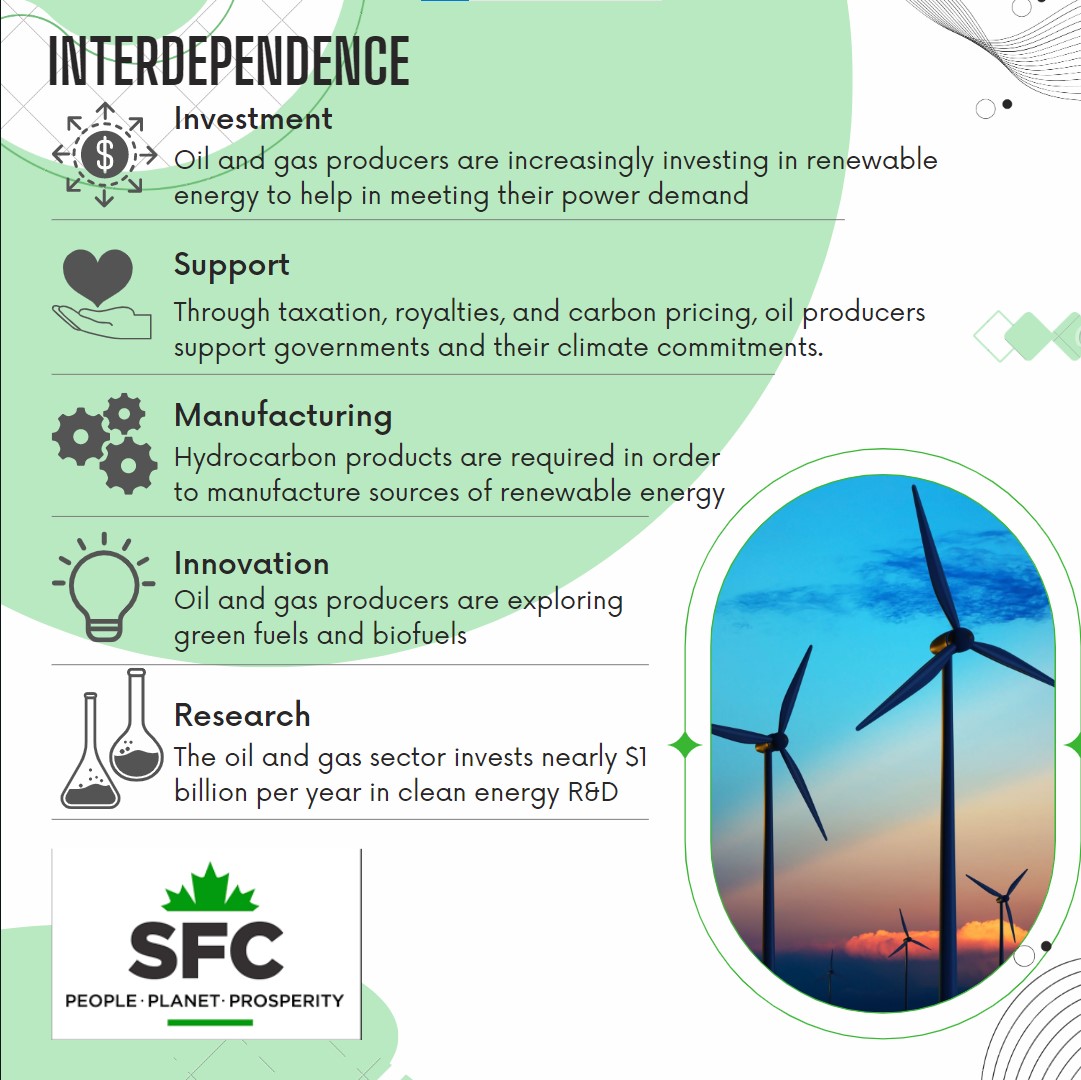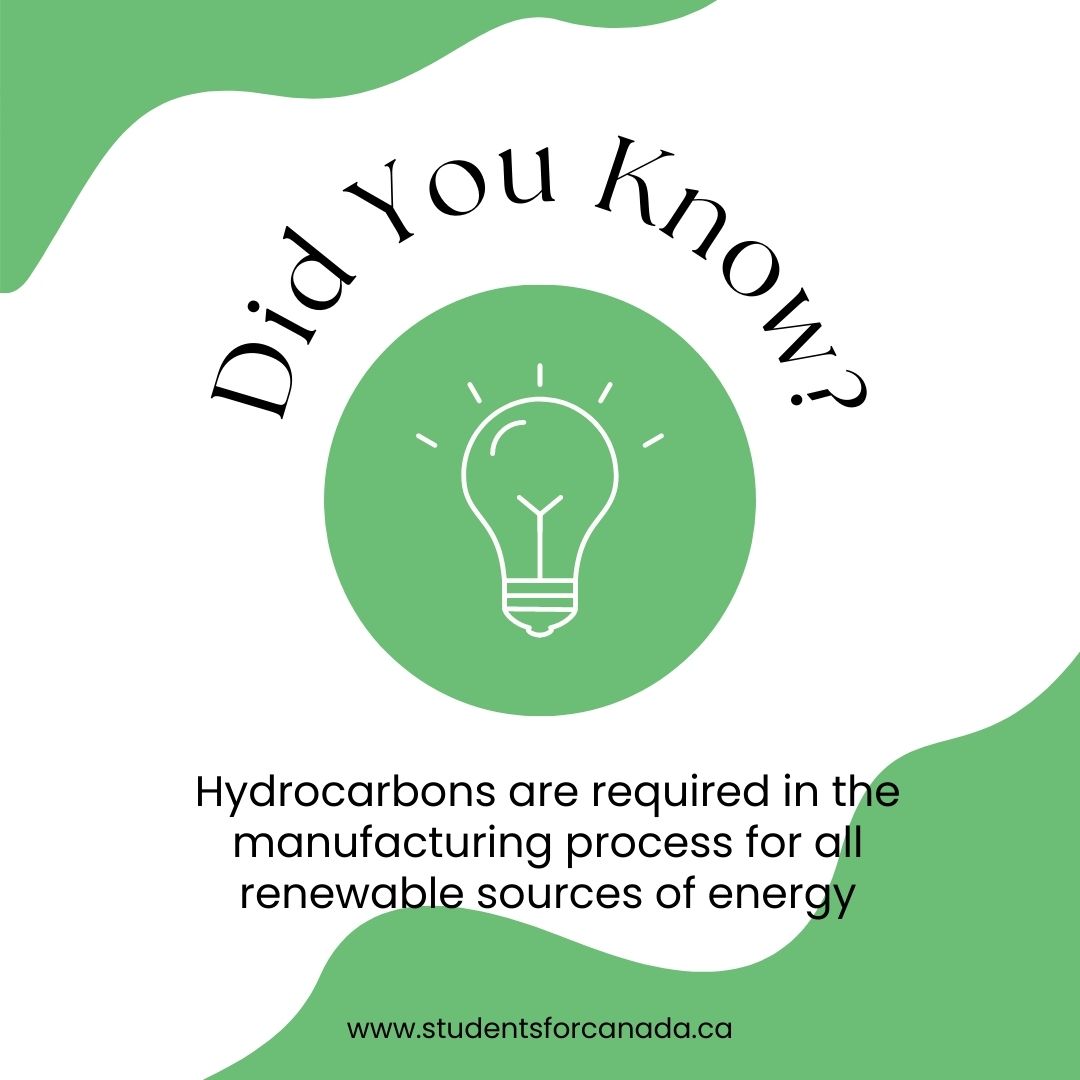Bjorn Anderson, Elysia Feaver, Jared Bowman, Nadhiya Koickel – October 17, 2022
About The Campaign:
Advocating for the Interdependancy of Oil & Gas and Renewable Energy
Each of these students were summer interns at Crew Energy in 2022. Each chose to participate in SFC’s Summer Advocacy Challenge. They hope to impact their peers and change the outlook on Canada’s Energy Industy.

Our Message
There is an “all-or-nothing” attitude about transitioning to cleaner sources, contributing to the currently polarized socio-political situation. Many people doubt whether we should still be producing oil and gas, whether we should still be mining, whether we should still be logging, and more. Others vilify those who work in these industries, ignoring how deeply interconnected the resource sector is with the rest of the Canadian economy. The resource sectors are profoundly interdependent with renewable energy, and it is important that Canadians recognize that it is necessary to interweave natural resources with sources of renewable energy. There is no larger supporter of renewable energy than Canadian Oil & Gas!
Natural resources are involved heavily in the production of sources of renewable energy. Every solar panel contains PVC, a hydrocarbon derivative, as well as countless mined minerals. Wind turbines require plastics by the ton and use significant amounts of carbon fibre, both of which are petrochemical products. Wind power also demands massive varieties of mined commodities.
Hydroelectric dams and nuclear power plants require incomprehensible volumes of steel and concrete. Both steel and concrete require significant heating at various stages of their production which can only be achieved in a blast furnace running on natural gas. If we wish to build with steel and concrete in Canada, we will need to be a producer of oil and gas. Biomass reactors often use byproducts of pulp and paper mills as fuel, products which come from the forestry industry in Canada. As we transition more and more toward renewable energy, we will require more and more of our natural resources.
Oil & Gas Leading the Way
The resource sector also leads renewable energy projects directly. Canada’s Oil & Gas sector has taken steps to invest in renewable energy, which has helped Canada to decrease its emissions from electricity production by 50% between 2010 and 2018. Suncor, a leading producer of oil and gas in Canada, has developed eight wind energy-related projects in Canada since 2002, and is currently developing Alberta’s Forty Mile Solar installation. Suncor has also been producing renewable fuels and hydrogen, helping them to reach their goal of net-zero emissions. Last year, Enbridge completed a 10.5-megawatt, 36 000 panel solar farm in Southern Alberta, enough to power approximately 3000 Canadian homes.
Even the companies that are not currently expanding into renewable and alternative sources of energy still have the environment in mind. Canadian Natural Resources Limited has reduced its emissions by 18% between 2016 and 2020 and has made investments in carbon capture technology, a significant change for such a large producer. Cenovus reduced its emissions by 30% over the past ten years, with plans to cut emissions by a further 35% by 2035. Imperial Oil has cut their own emissions by 20% in the period from 2013 to 2017, with plans to cut emissions by a further 30% by 2030. Montem, a mining company, has agreed to cooperate with the Alberta government in building a renewable energy facility. As it turns out, resource-based companies have been getting increasingly conscious of the environment for quite a while, yet popular discourse seems to vilify these organizations and their products.
The Canadian Minister of Natural Resources also had some interesting points in the Departmental Plan for Natural Resources Canada (Page 5):
“Our mining industry is a global leader in environmental practices and corporate social responsibility. Our forests, which account for nine percent of the world’s trees, are the most sustainably managed, and offer a natural solution to climate change. Our electricity mix is among the cleanest. And our world-class nuclear regulator has allowed nuclear power to safely move whole parts of the country away from coal.”
No industry in the resource sector is more misunderstood or polarized as oil and gas. The polarizing narrative revolves around climate action, an important focus for Canadians. As such, it has always been surprising to us that we aren’t proud of our oil and gas industry, which conforms to some of the tightest environmental regulations in the world.
The future success of the industry is dependent on reducing emissions and increasing efficiency in global markets where buyers demand cleaner and greener oil and gas products. The oilsands, which have been viewed in an unsavory way in the past, have dropped their greenhouse gas output by 23% since 2012. The oilsands now only emit about 5% more than the global average while providing Canada with considerable revenue.
We may have made some impressive progress, but there is much waiting in the future as well and much to improve upon. Carbon capture and carbon sequestration are becoming increasingly popular as means of reaching net zero emissions. Carbon capture utilization and storage (CCUS) systems are being utilized at many carbon-emitting industrial sites. These systems capture and compress carbon dioxide, which is pressurized and often injected into a geological formation. There are even initiatives aimed at turning the captured carbon into valuable commodities – building materials, alternative fuels, and even spirits!
The Challenges Ahead
Unfortunately, many sources of renewable energy are still a long way out from being implemented at the societal scale. One of the central problems faced by renewable energy sources is that it is incredibly difficult to adequately store energy for later use. The high energy density and availability of hydrocarbons make them strong candidates for generating on-demand power, but many other methods require energy storage. In the case of solar and wind energy, it’s important that energy can be stored for when the sun doesn’t shine, and the wind doesn’t blow. This is something Canadian renewable energy sources still struggle with.
The current solution to this energy storage problem is using batteries to store for later use, but have their own problems to deal with. They are incredibly expensive and hard to ship. They can be dangerous and are often filled to the brim with caustic acids. This makes a loss of containment in a residential area an incredibly frightening prospect. They are also often not particularly efficient, dissipating stored energy over time, and losing capacity with use. It is also difficult to store enough energy to meet any significant demand. Unfortunately, the technology seems not to have caught up with the aspirations of the public.

We can still rejoice though, in that 65% or more of our electricity generation in Canada comes from renewable sources. Canada has the 7th largest capacity of renewable energy in the world as of 2020. We can and should make efforts to increase our reliance on renewable energy, but we need to understand that we will still have to be sourcing energy from hydrocarbons for the foreseeable future. We would all like to get our power solely from renewable sources, but this is not a possibility yet! That’s why Canada must continue to use natural resources to provide energy for communities where renewable energy is not reliable, accessible, or affordable. Check out this article from Natural Resources Canada about the significance of renewable energy.
There is a notion among some Canadians that we could decrease our reliance on natural resources (primarily oil, gas, and lumber) by ramping down production. While eliminating fossil fuel use would be beneficial, with a high demand for resources to transport us and enable our modern style of living, lowering our production would just cause us to import more from countries that are not as environmentally or socially responsible. Canada has some of the most stringent environmental guidelines in the world, and we should look to support our own communities before spending money offshore. Canada needs to start supporting its domestic natural resource industries, which drive the manufacturing of renewable energy sources. A more sustainable, reliable, accessible, and affordable energy future won’t be solved by an all-or-nothing mindset.